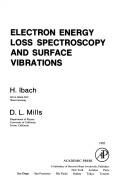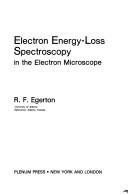| Listing 1 - 10 of 14 | << page >> |
Sort by
|

ISBN: 0873391802 Year: 1992 Publisher: Warrendale The minerals, metals and materials society
Abstract | Keywords | Export | Availability | Bookmark
 Loading...
Loading...Choose an application
- Reference Manager
- EndNote
- RefWorks (Direct export to RefWorks)

ISBN: 3540528180 3662138603 354047157X 9783540528180 Year: 1991 Volume: 63 Publisher: Berlin: Springer,
Abstract | Keywords | Export | Availability | Bookmark
 Loading...
Loading...Choose an application
- Reference Manager
- EndNote
- RefWorks (Direct export to RefWorks)
Electron energy loss spectroscopy. --- Spectrometer. --- Electron optics. --- Electron energy-loss spectroscopy --- Electron optics --- Spectrometer

ISBN: 0123693500 Year: 1982 Publisher: New York, NY : Academic Press,
Abstract | Keywords | Export | Availability | Bookmark
 Loading...
Loading...Choose an application
- Reference Manager
- EndNote
- RefWorks (Direct export to RefWorks)
Crystals --- Electron energy loss spectroscopy. --- Surfaces. --- CRYSTALS --- ELECTRON ENERGY LOSS SPECTROSCOPY --- SURFACES
Book
ISBN: 9789175197463 Year: 2012 Publisher: Linkopings Universitet
Abstract | Keywords | Export | Availability | Bookmark
 Loading...
Loading...Choose an application
- Reference Manager
- EndNote
- RefWorks (Direct export to RefWorks)
This dissertation by Justinas Pališaitis investigates the optical responses of group III-nitrides (AlN, GaN, InN) and their alloys using Valence Electron Energy Loss Spectroscopy (VEELS). The research aims to evaluate VEELS's effectiveness for nanoscale material analysis, focusing on bulk plasmon energy's relation to material composition and strain. The study explores the compositional analysis of Al1-xInxN layers and investigates the effect of strain on valence EELS. It also examines the thermal stability and degradation mechanisms of Al1-xInxN films and phase separation through thermal annealing. The findings provide insights into the growth and properties of III-nitride structures, contributing to advancements in electronic device materials. The intended audience includes researchers and professionals in materials science and condensed matter physics.

ISBN: 0306452235 147575101X 1475750994 9780306452239 Year: 1996 Publisher: New York: Plenum,
Abstract | Keywords | Export | Availability | Bookmark
 Loading...
Loading...Choose an application
- Reference Manager
- EndNote
- RefWorks (Direct export to RefWorks)

ISBN: 1859961347 Year: 2001 Publisher: Oxford : BIOS,
Abstract | Keywords | Export | Availability | Bookmark
 Loading...
Loading...Choose an application
- Reference Manager
- EndNote
- RefWorks (Direct export to RefWorks)

ISBN: 0306421585 1461568897 1461568870 Year: 1989 Publisher: New York Plenum Press
Abstract | Keywords | Export | Availability | Bookmark
 Loading...
Loading...Choose an application
- Reference Manager
- EndNote
- RefWorks (Direct export to RefWorks)
Experimental solid state physics --- Theoretical spectroscopy. Spectroscopic techniques --- fysicochemie --- Electron energy loss spectroscopy --- Electron microscopy --- Microscopy --- EELS (Spectrum analysis) --- Energy loss spectroscopy, Electron --- Spectroscopy, Electron energy loss --- Electron spectroscopy --- Electron microscopy. --- Electron energy-loss spectroscopy
Book
ISBN: 3540541624 0387541624 3540474730 9783540541622 9780387541624 Year: 1992 Volume: 69 Publisher: Berlin: Springer,
Abstract | Keywords | Export | Availability | Bookmark
 Loading...
Loading...Choose an application
- Reference Manager
- EndNote
- RefWorks (Direct export to RefWorks)
Electronics and optics of solids --- Photoelectron spectroscopy --- Solids --- Photoemission --- Electronic structure --- X-ray absorption near edge structure --- Electron energy loss spectroscopy --- Spectra --- Solids - Spectra --- ELECTRON ENERGY-LOSS SPECTROSCOPY --- ELECTRONIC STRUCTURE --- ENERGY LEVELS (QUANTUM MECHANICS) --- PHOTOELECTRON SPECTROSCOPY --- PHOTOEMISSION --- SOLIDS --- X-RAY ABSORPTION NEAR EDGE STRUCTURE --- SPECTRA
Book
ISBN: 0931288304 Year: 1984 Publisher: AMF O'Hare, Ill. Scanning Electron Microscopy
Abstract | Keywords | Export | Availability | Bookmark
 Loading...
Loading...Choose an application
- Reference Manager
- EndNote
- RefWorks (Direct export to RefWorks)
543.063 <063> --- Solids --- -Electron beams --- -Backscattering --- -Microlithography --- -Electron energy loss spectroscopy --- -Electrons --- -Corpuscular theory of matter --- Atoms --- Leptons (Nuclear physics) --- Matter --- Particles (Nuclear physics) --- Cathode rays --- Ions --- Positrons --- EELS (Spectrum analysis) --- Energy loss spectroscopy, Electron --- Spectroscopy, Electron energy loss --- Electron spectroscopy --- Lithography --- Microtechnology --- Back scatter --- Scattering (Physics) --- Beams, Electron --- Electron optics --- Electronics --- Particle beams --- Solid state physics --- Transparent solids --- 543.063 <063> Analytical chemistry--?.063--Congressen --- Analytical chemistry--?.063--Congressen --- Effect of radiation on --- -Congresses --- Congresses --- Backscattering --- Constitution --- Electron beams --- Electron energy loss spectroscopy --- Microlithography --- Faisceaux électroniques --- Scattering --- Diffusion --- Faisceaux électroniques --- Electronics and optics of solids --- Electrons --- Congrès --- Congresses.
Book
ISBN: 1606509187 9781606509180 9781606509173 Year: 2016 Publisher: New York [New York] (222 East 46th Street, New York, NY 10017)
Abstract | Keywords | Export | Availability | Bookmark
 Loading...
Loading...Choose an application
- Reference Manager
- EndNote
- RefWorks (Direct export to RefWorks)
Transmission electron microscope (TEM) is a very powerful tool for characterizing various types of materials. Using a light microscope, the imaging resolution is at several hundred nanometers, and for a scanning electron microscope, SEM, at several nanometers. The imaging resolution of the TEM, however, can routinely reach several angstroms on a modem instrument. In addition, the TEM can also provide material structural information, since the electrons penetrate through the thin specimens, and chemical compositional information due to the strong electron-specimen atom interactions. Nowadays, TEM is widely applied in diverse areas in both physical sciences (chemistry, engineering, geosciences, materials science, and physics) and life sciences (agriculture, biology, and medicine), playing a key role in research or development for material design, synthesis, processing, or performance. This book provides a concise practical guide to the TEM user, starting from the beginner level, including upper-division undergraduates, graduates, researchers, and engineers, on how to learn TEM efficiently in a short period of time. It is written primarily for materials science and engineering or related disciplines, while some applications in life sciences are also included. It covers most of the areas using TEM, including the instrumentation, sample preparation, diffraction, imaging, analytical microscopy, and some newly developed advanced microscopy techniques. In each topic, a theoretical background is firstly briefly outlined, followed with step-by-step instructions in experimental operation or computation. Some technical tips are given in order to obtain the best results. The practical procedures to acquire, analyze, and interpret the TEM data are therefore provided. This book may serve as a textbook for a TEM course or workshop, or a reference book for the TEM user to improve their TEM skills.
Transmission electron microscopy. --- Electron microscopy --- Analytical Electron Microscopy --- Ceramics --- Chemical Analysis --- Chemistry --- Composites --- Crystallography --- Electron Diffraction --- Electron Energy- Loss Spectroscopy (EELS) --- Forensic Science --- Geosciences --- Imaging --- Industry --- Life Sciences --- Materials Science and Engineering --- Metals and Alloys --- Microstructure --- Nanomaterials --- Nanoscience --- Nanotechnology --- Physics --- Scanning Transmission Electron Microscopy (STEM) --- Polymer --- Structure --- Transmission Electron Microscopy (TEM) --- X-ray Energy- Dispersive Spectroscopy (EDS)
| Listing 1 - 10 of 14 | << page >> |
Sort by
|

 Search
Search Feedback
Feedback About UniCat
About UniCat  Help
Help News
News